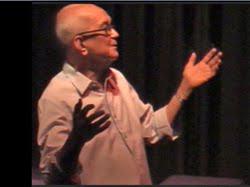ATENEO'S DULAANG SIBOL PRESENTS A PLAY THAT 'PROBES, DISTURBS'
 WHEN you ask an Atenean to describe to you what an Atenean is in three simple words, he will most probably say, “Man for others.”
WHEN you ask an Atenean to describe to you what an Atenean is in three simple words, he will most probably say, “Man for others.”
How to put this “man for others” on center stage of Ateneo’s Dulaang Sibol?
Of course, you can spotlight the presence of something by putting it dead-center. But sometimes it is more startling to spotlight something by its absence.
“Sa Kaharian ng Araw” explores the more exciting second option. What “Kaharian” puts on center-stage is not the “Man for others,” but his antithesis—the “Man-for-self,” in his many masks: the man-for-prestige, the man-for-possessions, the man-for-power.
But, at the end of the play, when the man-for-self confronts, in terror, the void in his life and pitifully screams his hollowness; what the audience sees is not only the shell of the man that is, but also the ghost of the man that could have been, and hopefully, in catharsis, the vision of the man the audience hopes to be.
Not comfortable
“Kaharian” is not a comfortable play to watch; it probes, it disturbs. It journeys through the first four scenes in unabashed fable-fresh simplicity, until it explodes unexpectedly in a shattering final scene.
“Kaharian” is reminiscent of the morality plays of the medieval ages, particularly, “Everyman.” Both plays revolve around a journey and centers around the journey’s end. Both plays try to illuminate what in life is truly of value.
The play ends even as it begins, still in the world of the users and the used, the abusers and the abused. Like rats, they race on, dead set on the vanished splendor of the Kaharian ng Araw.
When this writer chanced upon the first version of this play, as written by a 14-year-old Sibolista in second-year high school, this writer knew that here, indeed, was the raw material for a significant Sibol play.
And Dulaang Sibol tells this story at 6:30 p.m. on March 4, 5, 11, with its full, if limited arsenal, in theatercraft, prose threatening to leap into poetry, hopelessly Quixotic; music, a blend of folk and pop, idealistically young; sets and costume, stylistic, bravely Filipino.

